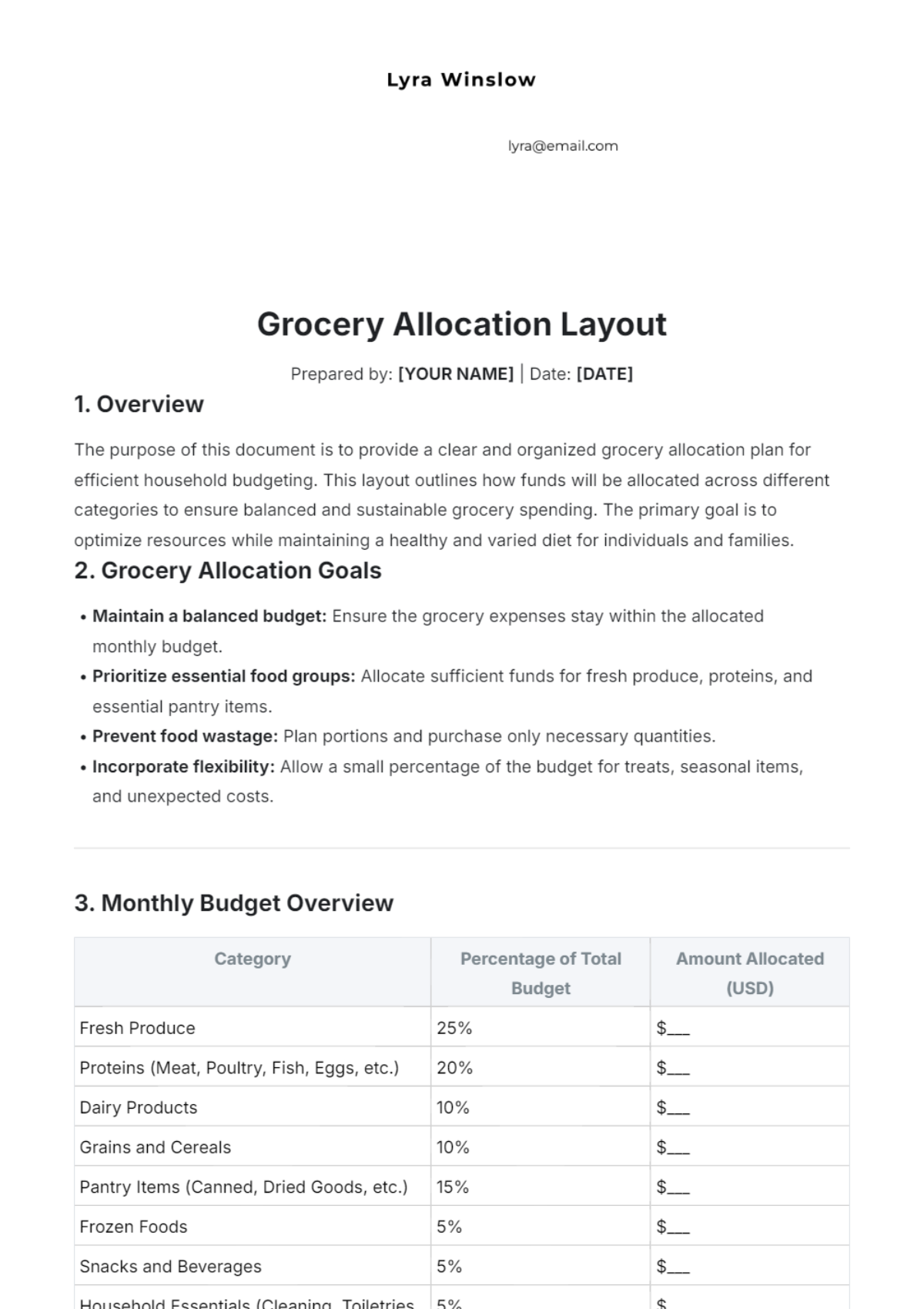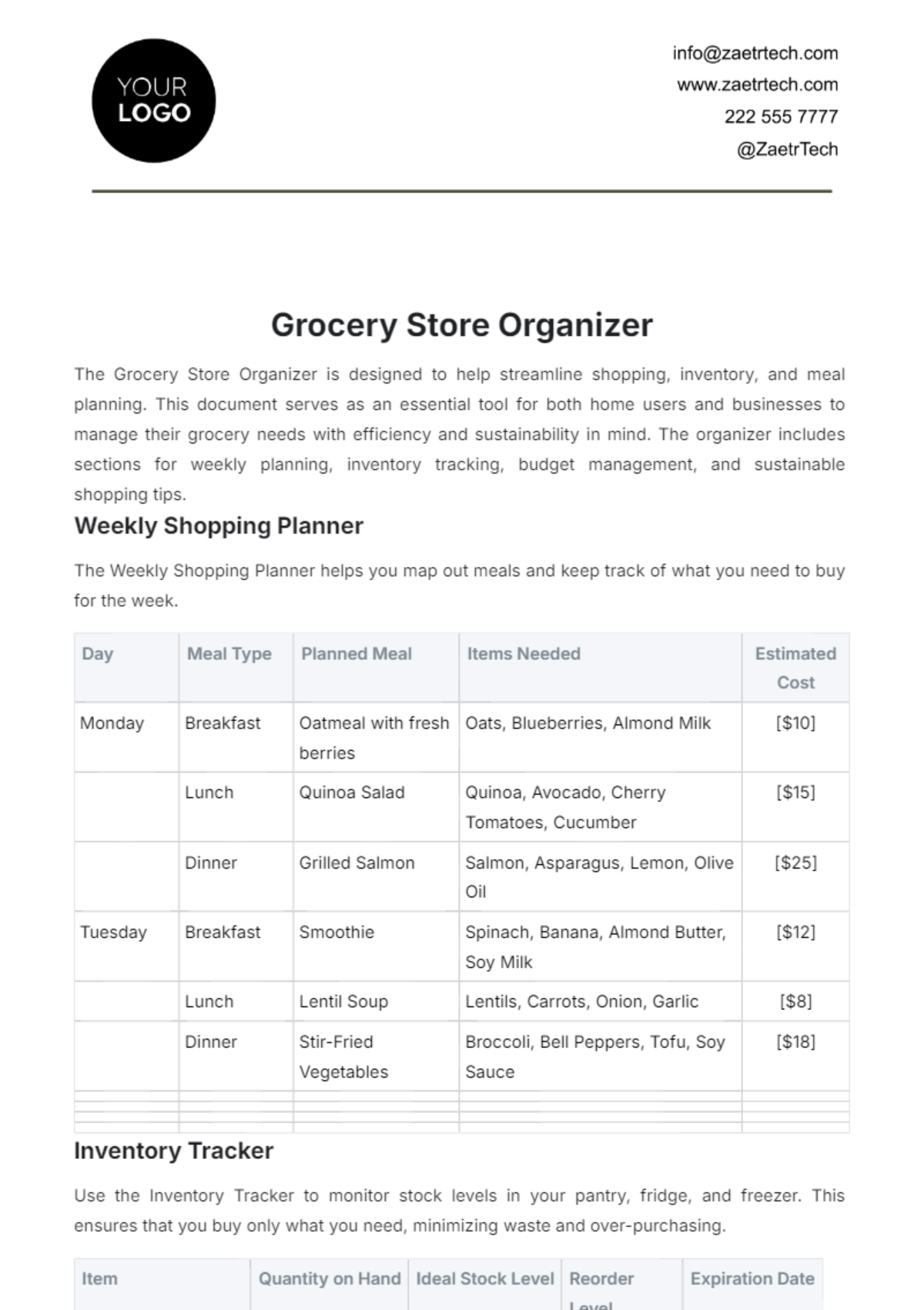Grocery Store SOP
I. Introduction
A. Purpose
This Standard Operating Procedure (SOP) provides a comprehensive framework for the daily operations, customer service, inventory management, cash handling, health and safety, employee responsibilities, vendor relations, maintenance, and compliance at [Your Company Name]. The purpose is to ensure uniformity, efficiency, and high standards across all aspects of store operations.
B. Scope
This SOP applies to all employees, including management, cashiers, stock clerks, supervisors, and support staff at [Your Company Name]. It covers procedures from store opening to closing, including all operational tasks, safety protocols, and compliance requirements.
C. Applicability
This SOP is applicable to daily operations at [Your Company Name] and is intended to be used as a reference for all staff members to ensure that tasks are performed consistently and in accordance with company policies and industry standards.
D. Definitions
SOP: Standard Operating Procedure - A documented process to achieve uniformity and efficiency in operations.
Cash Register: A point-of-sale device used for processing transactions and handling cash.
Inventory: A complete list of goods available for sale, including their quantities and locations.
II. Store Operations
A. Opening Procedures
Store Preparation
Conduct a comprehensive inspection of the store to ensure all areas are clean, organized, and free from safety hazards.
Check that all equipment, including refrigeration units and lighting, is functioning correctly.
Restock shelves based on the replenishment plan, ensuring displays are attractive and well-organized.
Cash Register Setup
Verify the starting cash amount in the register and ensure it matches the expected balance.
Ensure all POS system components, such as barcode scanners and receipt printers, are operational and properly connected.
Perform a test transaction to confirm the register is functioning correctly.
Safety Checks
Conduct a thorough safety inspection, including checking fire extinguishers, emergency exits, and first aid kits.
Identify and address any potential slip or trip hazards, such as spills or obstructions, in customer areas.
Initial Inventory Checks
Perform an initial inventory check to ensure perishable items are correctly stored and at appropriate temperatures.
Review the inventory list to identify any urgent restocking needs and address them promptly.
B. Closing Procedures
End-of-Day Sales Reporting
Generate detailed end-of-day sales reports and review them for accuracy, identifying any discrepancies.
Document any issues or anomalies and prepare a summary for management review.
Cash Register Reconciliation
Reconcile the cash drawer with the sales reports, ensuring all cash and receipts match.
Prepare the cash deposit for secure transport to the bank, following all security procedures.
Security Checks
Conduct a thorough security check, ensuring all doors and windows are securely locked.
Activate the store’s alarm system and verify that it is functioning correctly.
Store Lock-Up
Perform a final walkthrough of the store to ensure all areas are secured and no one is left inside.
Lock all access points and set the store's security system to its highest alert level.
III. Customer Service
A. Customer Interaction
Greeting and Assistance
Provide a warm and welcoming greeting to all customers as they enter the store.
Offer assistance with locating products, answering questions, and providing information on promotions.
Maintain a professional and helpful demeanor throughout the customer’s visit.
Handling Complaints
Listen actively to customer complaints, demonstrating empathy and understanding.
Apologize for any inconvenience and offer practical solutions or escalate the issue to a manager if necessary.
Follow up to ensure the customer’s issue has been resolved to their satisfaction.
Processing Returns and Exchanges
Verify the original purchase receipt and inspect the condition of the returned item.
Process the return or exchange according to store policy, ensuring that inventory records are updated accordingly.
Communicate clearly with the customer about the return or exchange process and any applicable fees or conditions.
B. Service Standards
Store Appearance
Ensure the store maintains a clean, organized, and visually appealing environment at all times.
Regularly inspect and address any areas of concern, such as spills, clutter, or disorganized shelves.
Employee Conduct
Employees should adhere to the store's dress code and maintain a professional appearance.
Demonstrate courteous and respectful behavior towards customers and colleagues at all times.
Problem Resolution
Address customer concerns promptly and effectively, ensuring that their issues are resolved satisfactorily.
Document and review customer feedback to identify areas for improvement and implement necessary changes.
IV. Inventory Management
A. Ordering and Receiving
Order Placement
Review current inventory levels and place orders based on established reorder points and sales forecasts.
Confirm order quantities, delivery dates, and any special instructions with suppliers.
Delivery Procedures
Inspect all delivered goods for accuracy and quality, comparing them against purchase orders.
Document any discrepancies or damages and communicate them to the supplier for resolution.
Stock Verification
Perform a thorough check to verify that all received items match the purchase order.
Update inventory records to reflect new stock levels and adjust inventory management systems as necessary.
B. Stock Management
Shelf Organization
Ensure products are neatly arranged on shelves, with labels and pricing clearly visible.
Maintain a consistent layout to facilitate easy product location for customers.
Stock Rotation
Implement FIFO (First In, First Out) principles to ensure that older stock is sold before newer stock.
Regularly check for and remove expired or damaged products from the shelves.
Inventory Audits
Conduct regular physical inventory audits to verify stock levels and reconcile with inventory records.
Address any discrepancies identified during audits and adjust inventory management practices as needed.
C. Loss Prevention
Shrinkage Control
Implement security measures such as surveillance cameras, anti-theft tags, and employee training to reduce theft and loss.
Monitor and analyze shrinkage reports to identify trends and develop strategies to mitigate losses.
Theft Prevention
Train employees to recognize and report suspicious behavior and potential theft incidents.
Regularly review and update theft prevention strategies to enhance store security.
Reporting Procedures
Document and report all incidents of loss, theft, or damage to management.
Investigate incidents thoroughly and take corrective actions to prevent recurrence.
V. Cash Handling
A. Register Operations
Transaction Procedures
Process all sales transactions accurately and efficiently, using the cash register or POS system.
Verify payment methods, provide correct change, and issue receipts as required.
Handling Cash and Credit Transactions
Securely handle cash and process credit card payments according to established procedures.
Follow protocols for managing counterfeit money and reporting suspicious transactions.
Change Management
Ensure that the cash drawer is stocked with sufficient change throughout the shift.
Replenish the cash drawer as needed and document any changes in cash handling procedures.
B. Financial Reconciliation
Daily Cash Count
Perform a detailed count of the cash drawer at the end of each shift, comparing it with sales reports.
Document and report any discrepancies between the expected and actual cash amounts.
Deposits and Withdrawals
Prepare cash deposits for secure transport to the bank, following all security protocols.
Record any withdrawals or adjustments accurately in the financial records.
Error Reporting
Report any errors or discrepancies in cash handling to management immediately.
Investigate and resolve any issues, implementing corrective actions to prevent future occurrences.
VI. Health and Safety
A. Store Cleanliness
Cleaning Schedules
Implement and adhere to a detailed cleaning schedule for all areas of the store, including floors, shelves, and restrooms.
Assign cleaning tasks to staff and ensure they are completed to a high standard.
Waste Management
Follow proper procedures for waste disposal and recycling, adhering to local regulations and environmental guidelines.
Maintain clean and organized waste disposal areas to prevent contamination and odors.
Sanitization Practices
Use approved cleaning agents and techniques to ensure a hygienic environment.
Regularly sanitize high-touch surfaces, including door handles, countertops, and checkout areas.
B. Food Safety
Handling and Storage
Adhere to food handling guidelines to prevent contamination and ensure product safety.
Store perishable items at the correct temperatures and follow proper storage practices.
Temperature Control
Monitor and record the temperatures of refrigeration and freezer units regularly.
Address any deviations from the recommended temperature ranges immediately.
Expiry Date Management
Regularly check product expiry dates and remove expired items from shelves.
Implement stock rotation practices to ensure older products are sold before newer stock.
C. Emergency Procedures
Fire Safety
Ensure that fire extinguishers are readily accessible and regularly inspected.
Conduct fire drills and train employees on fire evacuation procedures.
First Aid
Maintain fully stocked first aid kits and ensure employees are trained in basic first aid procedures.
Document and report any accidents or injuries that occur on the premises.
Incident Reporting
Report and document all incidents, including accidents, injuries, and security breaches.
Review incident reports to identify trends and implement preventive measures.
VII. Employee Responsibilities
A. Role Expectations
Job Descriptions
Provide detailed job descriptions outlining key responsibilities and performance expectations for each role.
Ensure employees understand their job duties and how their role contributes to store operations.
Performance Standards
Set clear performance standards and provide regular feedback to employees.
Conduct performance reviews to assess employee progress and identify areas for development.
B. Training and Development
Onboarding
Provide comprehensive onboarding training for new hires, including store policies, procedures, and safety protocols.
Assign a mentor or supervisor to guide new employees during their initial training period.
Ongoing Training
Offer regular training sessions to keep employees updated on new procedures, products, and technologies.
Encourage professional development and provide opportunities for skill enhancement.
C. Conduct and Discipline
Code of Conduct
Establish and communicate a code of conduct outlining expected behavior and professional standards.
Ensure employees understand and adhere to the store’s policies and procedures.
Disciplinary Actions
Implement a fair and consistent approach to addressing employee misconduct or performance issues.
Follow a documented disciplinary process, including verbal warnings, written warnings, and potential termination if necessary.
VIII. Vendor Relations
A. Supplier Management
Supplier Selection
Evaluate and select suppliers based on quality, reliability, and cost-effectiveness.
Establish clear criteria for assessing supplier performance and maintaining quality standards.
Ordering Procedures
Follow standardized procedures for placing orders with suppliers, including specifying product quantities, delivery dates, and payment terms.
Communicate any changes or issues with orders promptly to avoid disruptions.
B. Quality Control
Product Inspection
Inspect all received products for quality and compliance with specifications.
Address any issues or defects with suppliers and ensure that corrective actions are taken.
Feedback Mechanisms
Provide regular feedback to suppliers on product quality and service performance.
Collaborate with suppliers to resolve any issues and improve overall product offerings.
C. Contract Management
Contract Negotiations
Negotiate favorable terms and conditions with suppliers to ensure competitive pricing and reliable service.
Document and formalize agreements in written contracts.
Contract Compliance
Monitor supplier performance to ensure compliance with contract terms.
Address any deviations or breaches of contract promptly and take corrective actions as needed.
IX. Compliance
A. Legal and Regulatory Compliance
Local Regulations
Ensure that all store operations comply with local, state, and federal regulations, including labor laws, health and safety codes, and environmental regulations.
Regularly review and update policies to reflect changes in legislation and industry standards.
Licensing and Permits
Maintain up-to-date licenses and permits required for store operation, such as business licenses, health permits, and food handling certifications.
Ensure that all required documents are renewed before expiration and readily available for inspection.
B. Company Policies
Policy Adherence
Ensure all employees are familiar with and adhere to company policies, including those related to conduct, dress code, and customer service.
Regularly review and communicate any updates or changes to company policies.
Policy Review
Conduct periodic reviews of company policies and procedures to ensure they remain relevant and effective.
Involve employees in the review process to gather feedback and identify areas for improvement.
C. Record Keeping
Documentation Requirements
Maintain accurate and up-to-date records for all operational activities, including sales, inventory, employee records, and financial transactions.
Ensure records are stored securely and are easily accessible for review and compliance purposes.
Record Retention
Follow legal and regulatory requirements for record retention, including duration and storage conditions.
Develop a systematic approach for archiving and disposing of records to ensure compliance with data protection regulations.
X. Maintenance and Repairs
A. Routine Maintenance
Maintenance Schedule
Develop and adhere to a routine maintenance schedule for all store equipment and facilities, including HVAC systems, refrigeration units, and lighting.
Perform regular inspections and preventative maintenance to ensure equipment remains in good working condition.
Cleaning and Upkeep
Implement regular cleaning and upkeep procedures for store facilities, including floors, restrooms, and equipment.
Assign specific tasks to employees and ensure they are completed according to the maintenance schedule.
B. Repairs
Reporting Issues
Establish a clear process for reporting equipment malfunctions, facility issues, or other maintenance needs.
Document and prioritize reported issues to ensure timely resolution.
Repair Procedures
Arrange for repairs to be conducted by qualified personnel or contractors as needed.
Follow up on repairs to verify that they are completed satisfactorily and that the equipment or facility is returned to full functionality.
C. Vendor and Contractor Management
Vendor Selection
Select reputable vendors and contractors for maintenance and repair services based on qualifications, experience, and cost-effectiveness.
Negotiate contracts and service agreements to ensure clear expectations and performance standards.
Performance Monitoring
Monitor the performance of vendors and contractors to ensure they meet contractual obligations and service standards.
Address any issues or discrepancies with vendors promptly and take corrective actions as needed.
XI. Communication
A. Internal Communication
Staff Meetings
Conduct regular staff meetings to discuss store operations, address concerns, and share updates.
Encourage open communication and feedback from employees to foster a collaborative work environment.
Communication Channels
Utilize various communication channels, such as email, bulletin boards, and internal messaging systems, to disseminate important information and updates.
Ensure all employees are informed of key announcements and changes in policies or procedures.
B. External Communication
Customer Communication
Maintain clear and effective communication with customers regarding store policies, promotions, and services.
Use multiple platforms, such as social media, the store website, and in-store signage, to reach customers and provide relevant information.
Public Relations
Manage public relations and media interactions to promote a positive image of the store and address any community concerns.
Prepare and distribute press releases or statements as needed to communicate important news or updates.
XII. Evaluation and Improvement
A. Performance Evaluation
Key Performance Indicators (KPIs)
Establish and monitor KPIs to evaluate store performance in areas such as sales, customer satisfaction, and inventory management.
Use performance data to identify strengths, weaknesses, and areas for improvement.
Employee Performance Reviews
Conduct regular performance reviews for employees to assess their performance, provide feedback, and set development goals.
Document review outcomes and work with employees to address any performance issues or training needs.
B. Continuous Improvement
Feedback Collection
Collect feedback from customers, employees, and other stakeholders to identify areas for improvement and address concerns.
Use surveys, suggestion boxes, and direct feedback methods to gather input and assess satisfaction.
Process Improvement
Review and analyze operational processes to identify opportunities for improvement and implement best practices.
Develop and execute action plans to enhance efficiency, reduce costs, and improve overall store performance.
C. Audits and Reviews
Internal Audits
Conduct regular internal audits to ensure compliance with SOPs, regulatory requirements, and company policies.
Review audit findings and implement corrective actions to address any identified issues.
External Reviews
Prepare for and participate in external reviews or inspections conducted by regulatory agencies or third-party auditors.
Address any recommendations or findings from external reviews and ensure compliance with industry standards.
























